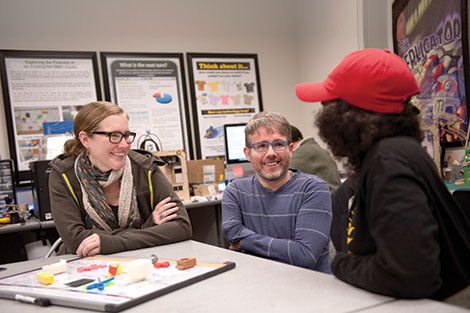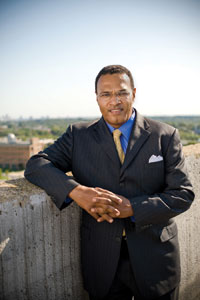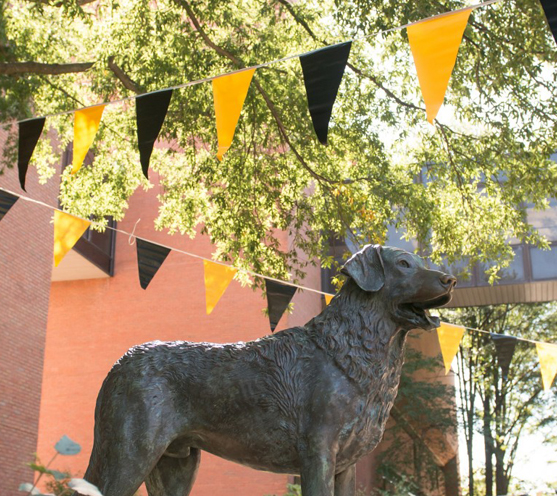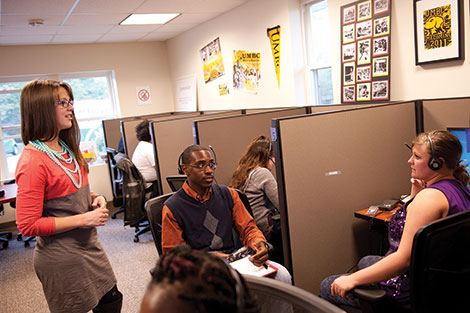Professors Amy Hurst and Shaun Kane have created a community that helps open up the world for people with disabilities through assistive technology.
By Kathryn Masterson
Every Monday morning at UMBC’s Prototyping and Design Lab (better known on campus as “The Pad”), Amy Hurst and Shaun Kane convene a meeting of students across disciplines who work in the space. Some of the students come to the lab to build things, but many are exploring how to use technology to make computers and the wider world accessible for people with disabilities.
Hurst and Kane are both assistant professors of human-centered computing in UMBC’s department of information systems. It’s a field that focuses on the user end of technology, combining elements of computer science, design, and behavioral science.
In mainstream human-computer interaction studies, Kane observes, the work often centers on making small improvements in a user’s computer experience, such as making a mouse respond better. In the accessibility research that Kane and Hurst focus on – which investigates how to put technology to work for people whose physical or mental disabilities make even simple tasks difficult – the chance for a breakthrough is higher.
“There is a great potential to make a substantial difference in people’s lives,” Kane says.
The projects that their students bring to Monday meetings are as diverse as the majors of the attendees. An engineering major is building a device to create plastic molds using a wooden box, a metal frame and what looks like a vacuum cleaner. An undergraduate biology major is experimenting with electroplating figures built using the lab’s 3-D printers. And a doctoral student in human centered computing is experimenting with ways to help visually impaired people choose outfits that are both fashionable and appropriate for different situations. Another engineer shows off a decorative lamp he created with “Twinkle”– The Pad’s collective nickname for its laser cutter.
Hurst and Kane help these students and others refine their ideas and provide positive and constructive feedback. Yet the weekly meeting is more than a taking of the pulse of campus undergraduate and graduate research being done. The gathering also reinforces a culture Hurst and Kane have intentionally built at The Pad: an atmosphere of collaboration and teamwork where members of the community are invested and involved in each other’s work.
“We really started to develop a community” in the past year, Hurst says. “You can go to the lab and know people will be there, all the time. Students have ownership of the space.”
Both professors observe that human centered computing is a field where sharing ideas, expertise and energy is the only pathway to success. After less than five years, their own collaborations with students and other faculty are already winning recognition and grants – and drawing those on campus who are interested in using technology to help people into their orbit.
Collaborators at The Pad don’t just revel in the act of creative partnership. Hurst and Kane also celebrate the simple joys of making and building in an atmosphere that allows for play and fun.
Kane insists that assistive technology that stretches beyond aiding in daily tasks can add richness to people’s lives. At times, Kane tells his students: “Let’s try to do something that’s not useful, that’s just for fun.”
USER FRIENDLY
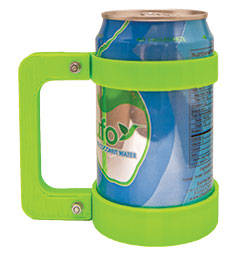 Assistive technology can be something as simple as the white cane used by a blind person to tiny wearable computers such as Google Glass, with which people with physical disabilities can take pictures, search the web and crowdsource opinions on various things. It is a field thathas opened up into new vistas in recent years, and Hurst and Kane and their research are right in the thick of it.
Assistive technology can be something as simple as the white cane used by a blind person to tiny wearable computers such as Google Glass, with which people with physical disabilities can take pictures, search the web and crowdsource opinions on various things. It is a field thathas opened up into new vistas in recent years, and Hurst and Kane and their research are right in the thick of it.
Smartphones, tablets and other handheld technology gadgets are putting greater computing power at the fingertips of the population as a whole. Developments in 3-D printers, which can produce prototypes more quickly and cheaply, are also pushing the possibilities forward.
“The work is really exciting,” Kane says. “There is a lot of potential.”
Both in The PAD and in other research, Hurst and Kane design assistive technology for people with visual impairments, aphasia, and also people with motor-control issues that make it difficult for them to point and click.
One important mantra in the field of accessibility and human computer interaction is: “You are not your user.”
It’s an admonition of sorts for the designers and engineers involved to look beyond themselves and put themselves in the place of (or better yet, collaborate with) the people who will use the technology.
One of the problems of assistive technology is that users commonly abandon it if it does not meet their specific wants or needs. So getting feedback from the users is critical if assistive technology is to be both useful and used.
Hurst believes the best way to get true feedback is to dive in and volunteer with groups that serve the disabled and build relationships that will guide research. As a Ph.D. student at Carnegie Mellon University, Hurst spent three years working at a cerebral palsy center in Pittsburgh. Her time in the center’s computer lab led her to research software that detects when someone seems to be having a problem operating a computer. (She recently received a grant from the National Institute on Disability and Rehabilitation Research to continue that work.)
“Go out and find ways to do service,” Hurst says. “I make my students do that.”
One of Hurst and Kane’s Ph.D.students, Patrick Carrington ’16, spent last summer volunteering in a spinal cord clinic in Baltimore to further his research on developing interfaces for power wheelchairs. He worked as a therapy tech, helping people from their wheelchairs to therapy mats and working with physical therapists.
Working alongside colleagues at the center allowed Carrington to develop relationships with people for whom he was designing technology. “I didn’t have to sit and be creepy in the corner,” he says.
At times, the relationships go beyond volunteering into direct collaboration. Working with the National Federation for the Blind in Baltimore, Hurst and Kane developed tactile plates to help display traditionally visual information – graphs of equations, or a picture from the Hubble telescope – as plastic plates that people could touch to understand shapes or curves.
The tactile plates may seem plain when compared to the sleek design of a pair of Google Glasses. But for a visually impaired person, the plates not only offer a chance to better understand something they may not have been able to access before, but are something they can create themselves on a 3-D printer.
In 2012, Kane, Hurst and several students travelled to New York to display these tactile plates, Braille rings and other pieces at Maker Faire – an invention festival that attracts thousands of people. Their work received the festival’s editor’s choice award and a blue ribbon hangs right inside the front door of the Pad.
“AMYANDSHAUN”
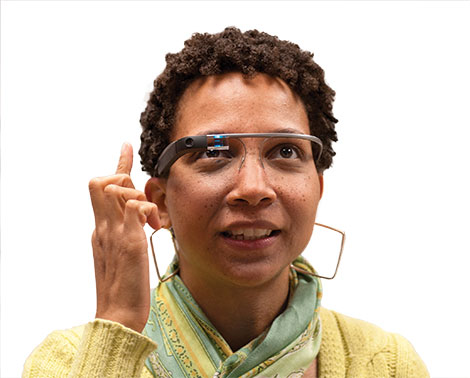 Michele Williams ’16 is a doctoral student who works with both professors. She specializes in developing navigation aids for the blind and in helping make fashion more accessible to blind people. She says that the success of The Pad and its collaborative atmosphere are rooted in the deep partnership between Hurst and Kane.
Michele Williams ’16 is a doctoral student who works with both professors. She specializes in developing navigation aids for the blind and in helping make fashion more accessible to blind people. She says that the success of The Pad and its collaborative atmosphere are rooted in the deep partnership between Hurst and Kane.
Williams say that students often refer to as a single entity: “You say it all as one: AmyandShaun.”
Hurst grew up in California, making things with her dad in the family garage. She recalls that as an undergraduate studying computer science at Georgia Tech, she was more inspired by what technology could do for people than what the latest trends in software were.
The possibilities to use technology to help people really clicked for her, Hurst says, when she participated in research at a hospital clinic involving patients with Parkinson’s disease. The effort to develop software that would replace a paper test for detecting tremors didn’t go anywhere, but the experience of working with people in need and using technology to assist them stayed with her.
Kane, who grew up in Massachusetts, was born with a physical disability. His limbs are short and he has the use of only one arm and hand. When he was younger, he recalls, the “moody teenager” in him was resistant to doing work involving disability. But after enrolling at the University of Massachusetts at Amherst, Kane observed a class that was designing toys for an autistic boy. The design challenges of the work, coupled with the altruistic possibilities, appealed to him.
Hurst and Kane’s collaboration started in graduate school, when Hurst, a Ph.D. student at Carnegie Mellon, approached Kane, who was studying at the University of Washington, at a conference. She introduced herself and told him they should get to know each other because they had worked with the same people and did similar work. Soon, they were seeing each other at conferences, skipping sessions to take walks and talk.
When it came time to look for jobs (Hurst completed her Ph.D. in 2010; Kane in 2011) neither one of them wanted to teach at a university or department where they were only researchers working in their area of interest. So they both were attracted by UMBC’s information systems department – which boasts one of the few human computer interaction specializations in the country – and by the breadth of knowledge among the faculty at the university.
“Being in a place with a lot of experts makes it really fun,” Hurst says.
MAKING GOOD
There is a sign on the door of Hurst’s office: “Keep Calm and Make.” When she first visited UMBC, she remembers asking: “Where do you make stuff?”
UMBC did not have a specific space dedicated to the rapid prototyping necessary to keeping up with technology, so when Kane came to UMBC a year later, they launched The Pad.
The Pad is a place to collaborate and make. “We let people loose,” Hurst says. And after the Monday meeting, the students in The Pad go directly back to making things. There are the telltale bleeps and bloops of the 3-D printer, where Joshua Dutterer ’14, the lab’s resident prototyper, makes a Statue of Liberty figure that he will try to electroplate at Hurst’s suggestion.
Hurst wants Dutterer to make something that conducts electricity but is also beautiful, and then publish an article about it so he gets recognized for what he’s done. “I don’t think anyone else is doing this,” she says of Dutterer’s work. “It’s a nice opportunity for us to be first on the scene.”
The electroplating work also interests others in The Pad. For Carrington, it may offer a way for a power wheelchair to charge a tablet or another piece of technology on the go.
Work made by students at The Pad is celebrated a few steps inside the door in a “museum” – a bookshelf of toys, trinkets and small pieces of assistive technology built by 3-D printers. Braille rings, can openers and bottle holders for people who have problems gripping sit side by side with UMBC tchotchkes, interlocking puzzles, figurines of an angel, a DNA helix, a hand making the hang-ten sign, a Yoda head and an Iron Man reactor for a Halloween costume.
The smart, quirky ebullience of the museum is a reflection of the sort of students who end up finding a home in The Pad. Hurst and Kane say specific areas of study pursued by undergraduates or graduate students who show interest are less important than the qualities of independence, teamwork, adventure and a passion to build that they bring to The Pad.
“We demand passionate people,” says Hurst. “This environment does not work for everyone.”
It also helps to not take oneself too seriously. Hurst and Kane took the team out for a night of laser tag after a particularly intense deadline had passed.
REPLICATING SUCCESS
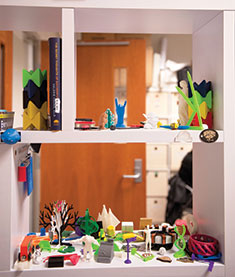 Hurst and Kane’s spirit of collaboration is starting to spread across campus.
Hurst and Kane’s spirit of collaboration is starting to spread across campus.
Each semester, The Pad hosts an intern from The Shriver Center’s SUCCESS program, which helps people with intellectual disabilities acquire post-secondary-school skills. These interns help with coding or other research, giving them job skill experience and making The Pad an even more diverse work space.
The duo’s research into assistive technology – and the energy of its students – has also been a key element in work done at The Erickson School. Judah Ronch, the school’s director, works with Hurst and Kane and their colleagues on projects that use technology to help the aging population. Ronch marvels at the possibilities of the work. “I think it’s really accelerated the rate we can develop solutions for the elderly,” he says.
Collaborating on societal problems with people who come from a multidisciplinary approach has been exciting and rewarding, Ronch says. “These are the kind of hybrid, interdisciplinary individuals our field needs. To them, nothing is not interesting, and nothing can’t be done. It encourages us to think bigger.”
The Pad is not a literal factory. The things made there are prototypes, not products. Yet even in the initial making, the work that Hurst and Kane and their students are doing is a leap into a world where technology can improve more lives of those whose existence is circumscribed by disability. Their intellectual contributions are helping to open up technology and the world beyond for many more people.
“The world is a better place when people can do the things they want to do without barriers,” says Kane.
Tags: Winter 2014

